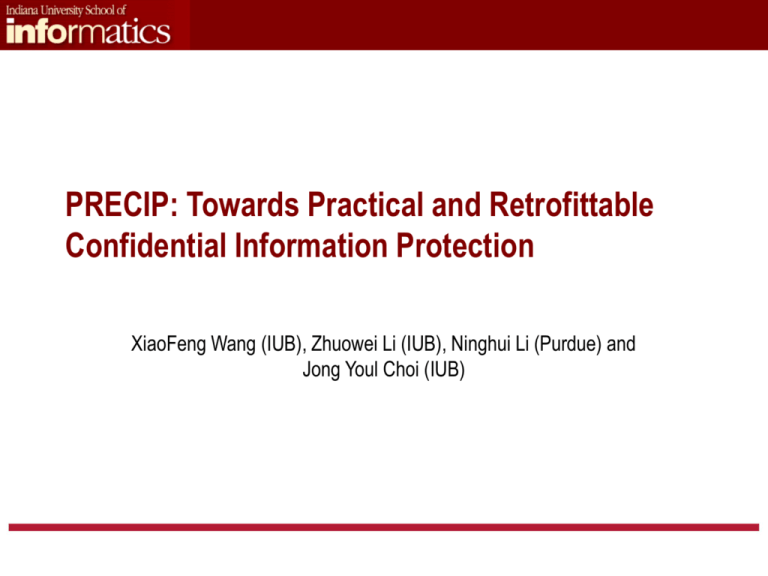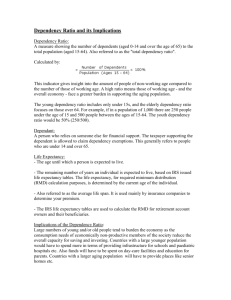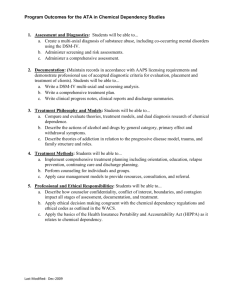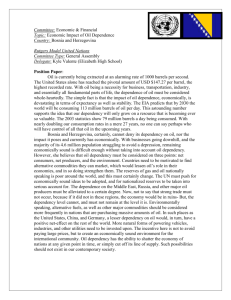PRECIP - System Security Lab at Indiana University
advertisement

PRECIP: Towards Practical and Retrofittable Confidential Information Protection XiaoFeng Wang (IUB), Zhuowei Li (IUB), Ninghui Li (Purdue) and Jong Youl Choi (IUB) How to protect your information from spyware? However… However… Prevent it ! Detect it ! The last defense line Contain unauthorized surveillance Spyware containment Existing access control mechanisms are insufficient Spyware can watch authorized party’s access to a secret Alternative: information flow security Track sensitive data Prevent them from flowing into unauthorized parties Information flow security The Bell-LaPadula model highly sensitive sensitive sensitive public However, this is insufficient for a modern OS User input object keyboard, mouse… When does it become sensitive? Other shared object screen, clipboard … sensitive? public? Multitasked subject Work concurrently on public and sensitive data Which output is sensitive? Requirements for a usable IF model Work on a modern OS Efficient enough for online operation Instruction-level tracking can be too slow Retrofittable to legacy systems Avoid modifying the source code of app, of OS PRECIP A first step towards practical and retrofittable confidential information protection Track an application’s input/output dependence Model input object and shared object Designed for online operations Retrofittable to legacy applications and OS The model Subjects and objects Local objects (files, buffers, keyboard, screen,…) Remote objects (website…) User input objects (UIO): objects for transferring inputs (keyboard) Channels Connect subject to subject, subject to object, object to subject A path is composed of multiple channels Messages Information on a channel in the form of “messages” Examples: keyboard events, mouse events, data through a “read” call The model (cont’d) Dependency relation Output messages depend on some input messages An input to the PRECIP model Sensitivity levels high: “sensitive”, low: “public” Trusted and untrusted subjects Untrusted: unknown dependency relations Trusted: all dependency relations are known Security objective Information is sensitive if it depends (directly or transitively) upon a message from an sensitive object, or sensitive inputs from an UIO Information leakage happens if Sensitive info gets into an untrusted subject or a remote public object Objective: Sensitive information shouldn’t be leaked Policies achieving the objective Tracing rules Sensitive msg: either from a sensitive obj or dependent upon a sensitive msg Obj sensitive if it receives a sensitive msg UIO sensitive iff a path connects it to a sensitive obj Obj public if it is cleaned Control rules Block sensitive msg to public remote obj and untrusted sub Sensitive info to a local obj block the msg or mark the obj sensitive Application of PRECIP to Windows XP Adversary model Spyware is not inside the kernel when PRECIP is installed However, our integrity protector can preventspyware to be installed through system calls PRECIP is not designed for preventing exploit of software vulnerabilities We use existing tools to do the job Classification and labeling Trust levels Classify applications according to dependency rules Mark an executable using its NTFS file stream Sensitivity levels Automatic classification: using a file’s DAC Dependency rules for editing/viewing App Sensitive Sensitive Sensitive Public Sensitive Public Sensitive Public Sensitive Public Dependency rules for web browsers Management of hooks Integrity protection Prevent unauthorized access of subject’s and object’s labels, contents and PRECIP settings Regulate calls related to file system, auto-start extensibility points and process Only allow signed kernel drivers to be loaded A policy also used in Windows Vista Evaluation Dependency rules Test dependency rules on Microsoft office, Adobe Acrobat and Notepad Quite effective in most cases Effectiveness Performance Effectiveness Performance Performance of hook management Baseline (no proxy): 691.015 microseconds PRECIP: 784.809 microseconds Overhead: 13.57% Performance of the kernel driver Evaluated using WorldBench 5.0 Limitations Dependency rules are empirical Research: automatic analysis of an application to generate rules Integrity model as a complementary Model is incomplete Multiple sensitivity levels Compartmentalization Related research Language-based information flow security For design of a new program Instruction-level tracking Hard to use online without hardware support New systems such as Abestos, IX, Flume,… Need to modify OS Sandboxing techniques Too coarse-grained Conclusions Propose a new confidentiality model for practical and retrofittable IF protection Application of the model to Windows XP Future research Improve the model Improve the techniques for enforcing the model





